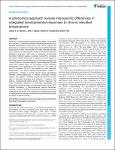A phenomics approach reveals interspecific differences in integrated developmental responses to chronic elevated temperatures
| dc.contributor.author | McCoy, JCS | |
| dc.contributor.author | Spicer, JI | |
| dc.contributor.author | Rundle, SD | |
| dc.contributor.author | Tills, O | |
| dc.date.accessioned | 2023-08-03T09:52:15Z | |
| dc.date.available | 2023-08-03T09:52:15Z | |
| dc.date.issued | 2023-06-29 | |
| dc.identifier.issn | 0022-0949 | |
| dc.identifier.issn | 1477-9145 | |
| dc.identifier.other | ARTN jeb245612 | |
| dc.identifier.uri | https://pearl.plymouth.ac.uk/handle/10026.1/21152 | |
| dc.description.abstract |
<jats:title>ABSTRACT</jats:title> <jats:p>Phenomics, high-dimensional organismal phenotyping, is advanced as a solution to quantifying complex developmental responses to elevated temperatures. ‘Energy proxy traits’ (EPTs) measure the phenotype as a spectrum of energy values across different temporal frequencies from pixel value fluctuations of video. Although they have proven effective in measuring the biology of complex and dynamic developing organisms, their utility in assessing environmental sensitivity of different species is untested. Using EPTs, we assess the relative thermal sensitivities of embryos of three species of freshwater snail with marked differences in their developmental event timings. Embryos of Lymnaea stagnalis, Radix balthica and Physella acuta were videoed hourly for the duration of their embryonic development at two temperatures: 20°C and 25°C. The video was used to calculate EPTs for the duration of their embryonic development, and during discrete physiological windows in development. Changes in energy spectra during development identified marked differences in thermal sensitivities between species, and suggest a relatively heightened sensitivity of gross rates of embryonic physiology and behaviour in embryos of R. balthica, developmental-window-specific thermal responses that reflect ontogenetic differences in observable physiologies, and temperature-induced changes in physiological event timing. EPTs enabled comparison of high-dimensional spectral phenotypes, providing a unique capability for assessing sensitivity continuously in developing individuals. Such integrative and scalable phenotyping is a prerequisite for improved understanding of the sensitivity of early life stages of different species.</jats:p> | |
| dc.format.extent | jeb245612- | |
| dc.format.medium | Print-Electronic | |
| dc.language | en | |
| dc.publisher | The Company of Biologists | |
| dc.subject | Development | |
| dc.subject | Thermal biology | |
| dc.subject | Embryo | |
| dc.subject | Comparative physiology | |
| dc.subject | Phenotyping | |
| dc.subject | Gastropods | |
| dc.title | A phenomics approach reveals interspecific differences in integrated developmental responses to chronic elevated temperatures | |
| dc.type | journal-article | |
| dc.type | Article | |
| plymouth.author-url | https://www.ncbi.nlm.nih.gov/pubmed/37358381 | |
| plymouth.issue | 12 | |
| plymouth.volume | 226 | |
| plymouth.publication-status | Published | |
| plymouth.journal | Journal of Experimental Biology | |
| dc.identifier.doi | 10.1242/jeb.245612 | |
| plymouth.organisational-group | |Plymouth | |
| plymouth.organisational-group | |Plymouth|Research Groups | |
| plymouth.organisational-group | |Plymouth|Faculty of Science and Engineering | |
| plymouth.organisational-group | |Plymouth|Faculty of Science and Engineering|School of Biological and Marine Sciences | |
| plymouth.organisational-group | |Plymouth|Research Groups|Marine Institute | |
| plymouth.organisational-group | |Plymouth|REF 2021 Researchers by UoA | |
| plymouth.organisational-group | |Plymouth|Users by role | |
| plymouth.organisational-group | |Plymouth|Users by role|Academics | |
| plymouth.organisational-group | |Plymouth|REF 2021 Researchers by UoA|UoA07 Earth Systems and Environmental Sciences | |
| plymouth.organisational-group | |Plymouth|Admin Group - REF | |
| plymouth.organisational-group | |Plymouth|Admin Group - REF|REF Admin Group - FoSE | |
| plymouth.organisational-group | |Plymouth|Users by role|Researchers in ResearchFish submission | |
| dc.publisher.place | England | |
| dcterms.dateAccepted | 2023-05-26 | |
| dc.date.updated | 2023-08-03T09:52:10Z | |
| dc.rights.embargodate | 2023-8-4 | |
| dc.identifier.eissn | 1477-9145 | |
| dc.rights.embargoperiod | forever | |
| rioxxterms.versionofrecord | 10.1242/jeb.245612 |


